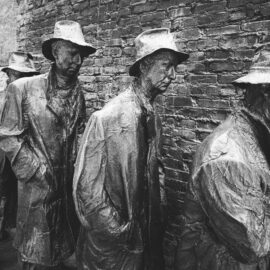
This is a free excerpt from one of Shortform’s Articles. We give you all the important information you need to know about current events and more.
Don't miss out on the whole story. Sign up for a free trial here .
Why are prices so high right now? When will inflation go down? Will prices go back to normal anytime soon?
Inflation, which took off in 2021, has surprised economists with its durability, remaining at levels not seen in 40 years. Recently, though, it’s started to decrease—however, prices for everything are so high that consumers are left wondering if they’ll ever return to normal.
Read on to learn why prices are so high right now and what economists predict will happen in the coming year.
Why Are Prices So High?
When inflation first started surging in 2021, many economists predicted it would quickly return to the Federal Reserve’s target of 2% once the world emerged from the pandemic-specific conditions that had sparked it. But long after Covid restrictions lifted, inflation remained stubbornly high; in 2022 it hit 9.1% in the U.S. (a 40-year record), 11.5% in Europe, and 11.1% in the UK. Recently, though, it’s started to subside, decreasing to 6.4% in the U.S., 8.6% in Europe, and 10.1% in the UK for January 2023. However, with the cost of food, gas, and other goods still rising, many are left wondering why prices are so high right now and when they will fall.
In this article, we’ll look at the factors driving inflation, why prices are still so high right now, and what the chances of a recession are.
The Factors Driving Inflation
The inflation of 2021-2022 had a number of causes, depending on the area of the economy:
- Goods: Increased consumer spending fueled by low interest rates, stimulus payments, and pandemic-induced spending met blocked-up supply chains and manufacturing difficulties, creating an imbalance between supply and demand that drove up prices.
- Housing: The pandemic sparked a run on housing as people fled cities and sought out larger homes to hunker down in, sending home prices to record levels.
- Services: A sudden shortage of workers during the pandemic prompted wage increases in many industries, leading businesses to raise prices.
- Energy: Electricity and gas prices rose sharply in both the U.S. and Europe due to continued pandemic factors as well as Russia’s invasion of Ukraine.
- Food: Transportation costs, climate change, a recent deadly bird flu, the conflict in Ukraine, and supply chain disruptions have all contributed to food inflation, which has outpaced overall inflation since early 2022.
In recent months, some of these pressures have lessened. Supply chains have healed, manufacturing problems have resolved, people are less desperate for new houses, and energy prices have fallen due to a warmer-than-expected winter.
Still, though, overall inflation remains well above central banks’ targets, in large part due to the continued labor shortage, which is keeping wages high. Many economists assumed that after the pandemic, workers would return, but Covid deaths, ongoing illnesses, tighter immigration policies, and—perhaps most significantly—the mass retirement of swaths of Baby Boomers has kept the labor market unexpectedly tight.
Efforts to Curb Inflation
In an effort to curb inflation, the Fed raised interest rates several times in 2022. The increases have so far had limited impact, as prices for goods still remain high right now for consumers. This is because it takes several months for such changes to work their way through the economy. With the recent slowing of inflation, the U.S. central bank has indicated it will start to back off additional increases. It expects to raise rates once or twice more, perhaps until they breach 5%, but then probably not much further.
Until the higher rates work their way fully through the economy, some areas of the economy are stuck in an uncomfortable middle ground where prices are decreasing but high rates still scare customers away. For example, prices for new and used cars have fallen in the past few months, but interest rates remain high right now, so for those who need a loan to purchase their car—the vast majority of buyers—prices remain high even though they’ve technically decreased.
Predictions for the Coming Year
Even with prices being so high right now, most economists expect inflation to cool by the end of the year. Some predict it will settle out at around 3% or 4%, and argue that this can be achieved without an economic slowdown by addressing factors like high fuel prices.
Others, though, don’t believe the Fed’s target is achievable without significant job losses, as only a softening jobs market will lessen pressures on wages and lead to less consumer spending (and thus less demand for products and services). Many think it’s likely that inflation will meet the Fed’s 2% target by the end of 2023, but not for happy reasons: They predict a coming recession will do the trick.

Want to fast-track your learning? With Shortform, you’ll gain insights you won't find anywhere else .
Here's what you’ll get when you sign up for Shortform :
- Complicated ideas explained in simple and concise ways
- Smart analysis that connects what you’re reading to other key concepts
- Writing with zero fluff because we know how important your time is






